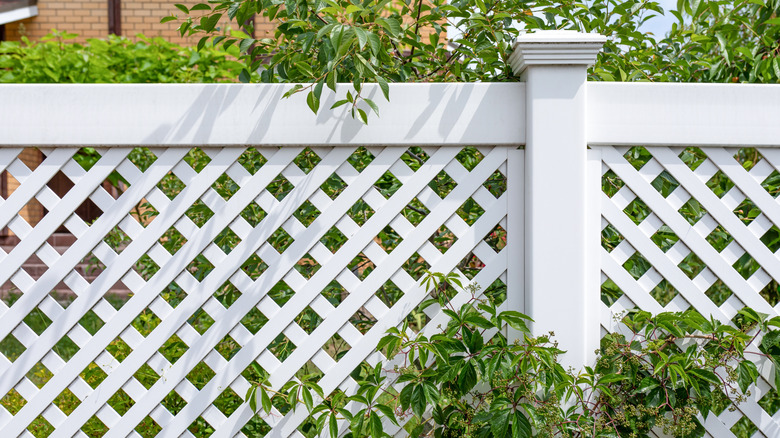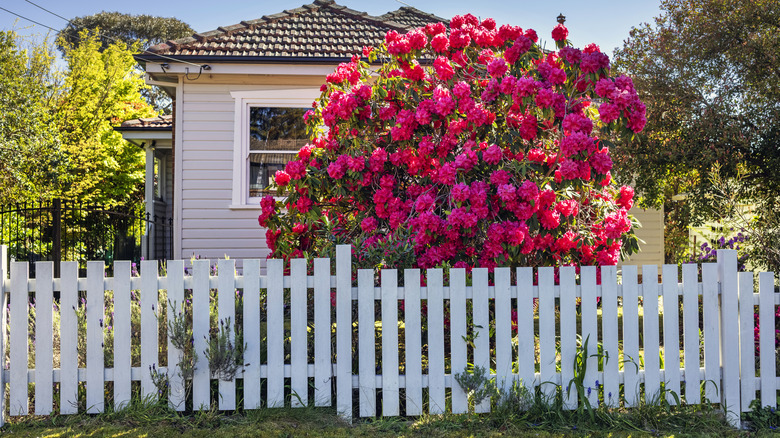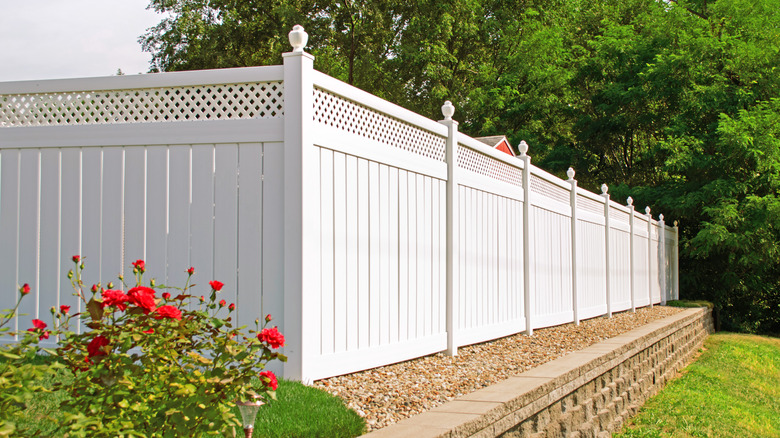Why Your Plants May Be Struggling Near A Vinyl Fence
Vinyl fencing is a popular pick for many homeowners — and for good reason. Since it's usually made of PVC, it's more resistant to warping in hot summer weather versus wood or metal fencing, and it requires little to no maintenance over time. However, if you're hoping to plant a dense garden near your fence, then you may want to choose a different material. Vinyl fencing can inadvertently disrupt the exposure to light, airflow, and water drainage in the soil surrounding it, creating the micro-est of micro-climates, which, in turn, can be detrimental to fussier plants in its vicinity. It can even block root distribution, restricting your plants' access to vital nutrients.
So, no, you're not imagining it: The plants in your garden might be looking a little worse for wear purely because of their proximity to your vinyl fencing. Granted, this is something you can work around. The solution could be as simple as, say, adjusting how often you water your plants. You could even replant them farther away from your fence so they're less affected by its micro-climate. That said, if you're an inexperienced gardener or you want your backyard landscaping to be truly low-maintenance, vinyl fencing might not be ideal for you.
A more plant-friendly alternative to vinyl fencing
Wood fencing is one alternative to vinyl that's less likely to jeopardize plants' growth. Since it's made of natural materials, wood is more breathable than vinyl, won't obstruct airflow, and is generally less expensive upfront. It also offers a classic or rustic aesthetic that's appealing to many homeowners. There are some potential drawbacks to wood fencing, though. Chief among them is its lack of durability. Unlike weather-resistant PVC, wood needs regular upkeep to prevent common fence damage issues, such as rotting or warping. Without the use of pest-repelling primer, stain, or paint, wood commonly attracts termites, which feed on the wood and can cause severe damage.
By contrast, vinyl fencing is impervious to pests, and a vinyl fence can last for 20 to 30 years with very little maintenance on your part, though it can fade over time or, in some cases, grow mold. Ultimately, it's a matter of your priorities. Are you primarily concerned with your fence's durability, or would you rather cultivate a flourishing garden right next to it with minimal interference? In the first scenario, vinyl fencing is probably your best bet; in the second, wood might be preferable.
Tips for planting a thriving garden near vinyl fencing
If you've already committed to vinyl fencing for your yard, don't panic. Simply adjust your landscaping practices to compensate for its non-ideal effects on your garden. For starters, plant selection is crucial. Be sure to choose plants that love shade or at least partial shade. If they're planted on the ground, they'll probably get less exposure to light depending on the height and design of your specific fencing.
You'll want to be extra mindful of how often your plants are getting watered and how well their soil drains — both considerations are key for successfully growing plants but can be negatively impacted by this type of fencing. In general, err on the side of overwatering, especially if you're experiencing minimal rain or drought conditions in your area. Opt for hardy plants that can grow in raised garden beds or tolerate a range of drainage levels, such as daylilies (Hemerocallis). That way, even if they're receiving less water or not draining properly on occasion, your plants will still have a fair shot at growing well. You can also experiment with vining or climbing plants like climbing roses (Rosa setigera), which can scale vinyl fencing and access the light or water they need to thrive.


